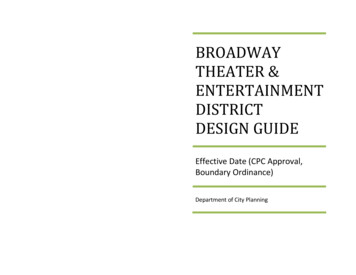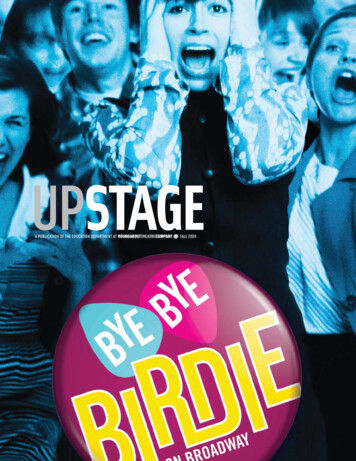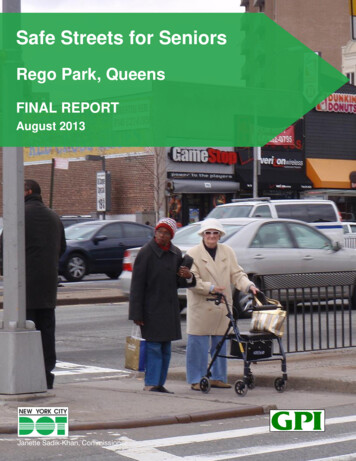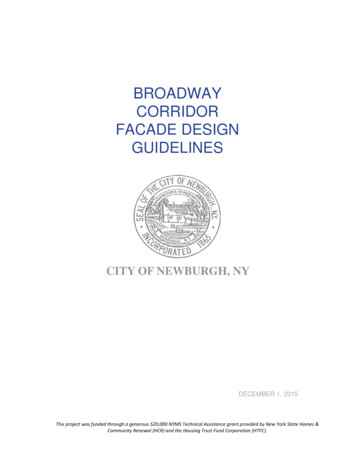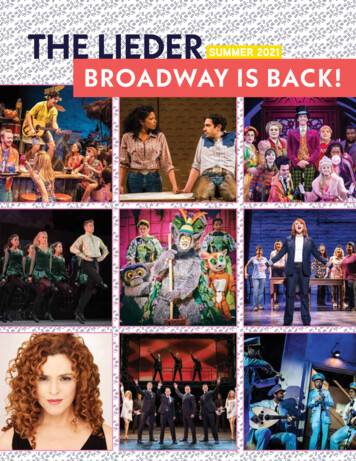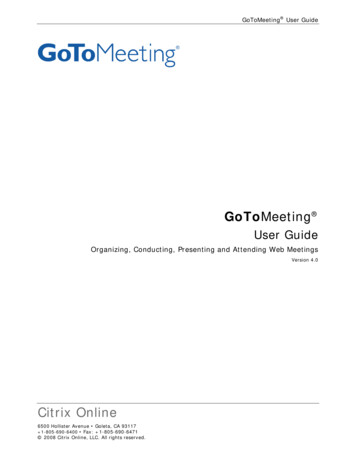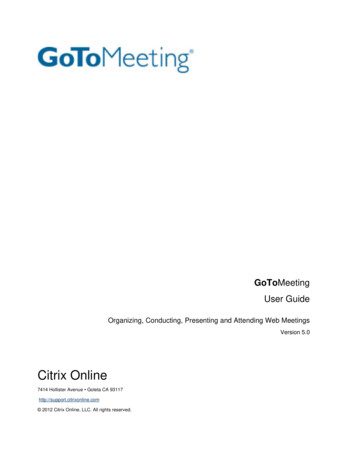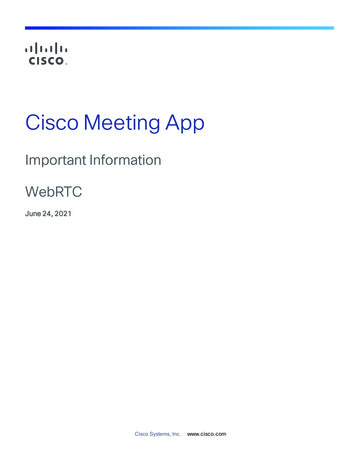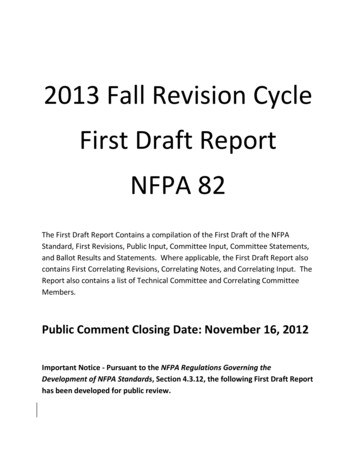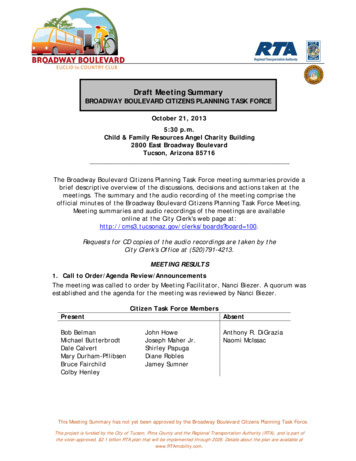
Transcription
Draft Meeting SummaryBROADWAY BOULEVARD CITIZENS PLANNING TASK FORCEOctober 21, 20135:30 p.m.Child & Family Resources Angel Charity Building2800 East Broadway BoulevardTucson, Arizona 85716The Broadway Boulevard Citizens Planning Task Force meeting summaries provide abrief descriptive overview of the discussions, decisions and actions taken at themeetings. The summary and the audio recording of the meeting comprise theofficial minutes of the Broadway Boulevard Citizens Planning Task Force Meeting.Meeting summaries and audio recordings of the meetings are availableonline at the City Clerk's web page at:http://cms3.tucsonaz.gov/clerks/boards?board 100.Requests for CD copies of the audio recordings are taken by theCity Clerk's Office at (520)791-4213.MEETING RESULTS1. Call to Order/Agenda Review/AnnouncementsThe meeting was called to order by Meeting Facilitator, Nanci Biezer. A quorum wasestablished and the agenda for the meeting was reviewed by Nanci Biezer.Citizen Task Force MembersPresentBob BelmanMichael ButterbrodtDale CalvertMary Durham-PflibsenBruce FairchildColby HenleyAbsentJohn HoweJoseph Maher Jr.Shirley PapugaDiane RoblesJamey SumnerAnthony R. DiGraziaNaomi McIssacThis Meeting Summary has not yet been approved by the Broadway Boulevard Citizens Planning Task Force.This project is funded by the City of Tucson, Pima County and the Regional Transportation Authority (RTA), and is part ofthe voter-approved, 2.1 billion RTA plan that will be implemented through 2026. Details about the plan are available atwww.RTAmobility.com.
Broadway: Euclid to Country ClubDraft October 21, 2013 CTF Meeting SummaryPage 2 of 272. First Call to the AudienceFive (5) members of the audience filled out a speaker’s card and were called uponto address the task force:Ron Spark“I am Ron Spark, I sit on the steering committee of the Southern Arizona TransitAdvocates, as well as the Broadway Coalition. I am also an ex-President of the ElEncanto Estates Neighborhood Association. I want to talk to you tonight aboutnecessity of a transit study and to construct a budget for this landscape/streetscape, specifically on operations and maintenance. I will touch on that. Ifeel that in order to plan for Broadway, you need quality data on both of thesethings which will give you vital information for your planners. How can you as atask force designate lanes for transit on Broadway (or off Broadway) withoutknowing the technical criteria and the financial implications from getting a formal,quality professional transit study?If you do go forward without a transit study the eventual cost will be much greaterlater on in several years than when the study is done. It will have to be re-financedand it may not be able to alter what it is that you have planned. So planningBroadway without a transit study will possibly limit high capacity options and add tonot only the cost but consequences.Gene Caywood and others on the SATA have made some proposals about highcapacity transit not only on Broadway but even off Broadway, and there has beensome discussion of bike highways on Broadway on 9th Street, 10th Street and thereare other options that might be uncovered by, again, a professional transit study.So this item must be moved from the backburner to the front burner before you canstart to make intelligent decisions. Again, because you will limit options and run upcosts.Landscaping Operations and Maintenance- We have been hearing a lot aboutlandscape, sidewalk, streetscape; look at Broadway . A lot of the landscaping hasbeen removed both for the cost of maintenance and also for right of way. There iscurrently no budget once you plan a streetscape, or put in landscape there is nobudget for the City to maintain or operate those. You have got to know what thosecosts are. There is a contract with the City (that is Groundskeeper), so there is abudgetary item to help you calculate the cost; but you are obligating the City forcertain costs and you have to know that before you make those decisions. I thinkyou should also think in terms of other design elements that you could recommendfor shade other than just landscaping. There are awnings, canvas awnings,ramadas, pergolas, and parquet’s; working with the City right of way, as well asprivate partnership to construct adequate shade along the Broadway corridor.The summary is: you need to know data, you need to know the costs, and you needto know where the money has to come from. I think you need to urge the City andthe RTA to come up with these moneys to do these studies. It could be animprovement district, it could be going back to the RTA, but I think it’s very vital atthis point to put these items in place. Thank you.”This Meeting Summary has not yet been approved by the Broadway Boulevard Citizens Planning Task Force.This project is funded by the City of Tucson, Pima County and the Regional Transportation Authority (RTA), and is part ofthe voter-approved, 2.1 billion RTA plan that will be implemented through 2026. Details about the plan are available atwww.RTAmobility.com.
Broadway: Euclid to Country ClubDraft October 21, 2013 CTF Meeting SummaryPage 3 of 27Steward Herzog“There was an article in the paper a couple days ago about the 25 million of Countybond money. I would like someone to explain what the impact would be if thatmoney is not available, and what the impact would be if it is available, also whatare the criteria if it will or will not be available?”Laura Tabili“Hi. I guess people know me. I am not speaking for the Broadway Coalition tonight,but just speaking for myself. As I was walking up here tonight, for the umpteenthtime, the umpteenth 3 hour meeting that interferes with dinner. I am sure that allthe task force members are very well aware of that with the amount of time that isbeing taken by each of these three hour meetings. I am also reflecting on a letterthat my neighborhood had wrote to you, that I think is in your packet and we havebeen really concerned with things that you need to know before you can actuallydesign the road.Some of us have been really concerned that task force members have been askingfor information and not getting it. For instance in May, Colby Henley forinformation on parking and how parking is going to fit into this. Now, four or fivemonths later that has not yet been produced. Mary Pflibsen has asked aboutPhoenix’s light rail system that information hasn’t been produced. Diane Robles,has asked repeatedly for updated traffic counts and projections and thatinformation hasn’t been produced. My neighborhood had sent a letter to urge youto put your foot down basically and make sure that that information is produced.We got a letter back from the design team that wasn’t very encouraging.I guess as I was walking up here, I was thinking, how can the task force beproceeding with meetings, two meetings this week (at 3 hours a piece). How canyou be proceeding with meetings to design the street when you don’t have theinformation that you need? I was also reminded that in fact, the mayor andcouncil’s ordinance had created the task force and that puts you in the driver’sseat, right? The task force is supposed to be making decisions about the agenda;the task force (I think) are empowered to not adjourn until you get the informationthat you need; rather than, in a sense be dragged through all these meetings whenyou really don’t have enough information. I think there are huge costs to this,volunteering for 3 hour meetings that just go on, and on, and on, withoutnecessarily getting the information that you need so I am just going to suggest toyou that you maybe think about putting your foot down on the system and insistingon getting that information and perhaps adjourning until get it so that you can useyour precious time efficiently.”Margot Garcia“Good evening, you are to be commended on a very successful public meeting #3.By all accounts, at least 200 people attended and one could see that they were veryengaged in each of the small group discussions. They also seem to of sent a clearmessage, bicycles and pedestrians are important, so is transit for local businesses,and their historic and architecturally significant buildings, and keep the street asnarrow as possible. In light of these comments, I wanted to bring to your attentionThis Meeting Summary has not yet been approved by the Broadway Boulevard Citizens Planning Task Force.This project is funded by the City of Tucson, Pima County and the Regional Transportation Authority (RTA), and is part ofthe voter-approved, 2.1 billion RTA plan that will be implemented through 2026. Details about the plan are available atwww.RTAmobility.com.
Broadway: Euclid to Country ClubDraft October 21, 2013 CTF Meeting SummaryPage 4 of 27a TED Talk, by Janette Sadik-Khan, the transportation commissioner of New YorkCity. Janette Sadik-Khan starts out by saying, “The work of a transportationcommissioner isn’t just about stop signs and traffic signals. It involves the design ofthe City and the design of city streets. Streets are some of the most valuableresources that a city has, and yet it’s an asset that is hardly hidden in plain sight.”She goes on to describe how streets like Time Square haven’t changed much in thelast 50 years. So she worked to refocus the agenda to “maximize efficient mobilityproviding more room for bikes, more room for people to enjoy the city for to makeour streets as safe as they can be for everybody who uses them”.So they wanted to change the balance and they tried it out in Time Square. Peoplehave tried for years to make it better, she relates, by changing signals, lanes, andeverything else they can think of, but it was still dangerous and hard to cross. Sothey tried looking at the street differently and they did a six month project. “Weclosed Broadway from 42nd to 47th street and created two and a half acres of newpedestrian space. Temporary materials are an important part of the programbecause we were able to show that it worked. I worked for a data driven mayor, asyou probably know, so it was all about the data. If it worked better for traffic orbetter for mobility, if it was safer or better for business we would keep it. If itdidn’t work no harm no foul and we could put it back the way it was beforebecause they were temporary materials. The results were overwhelming. Trafficmoved better, it was safer, five new flagship stores opened. It’s been a totalhomerun. Time Square is one of the top ten retail locations on the planet and this isan important lesson because it doesn’t need to be a zero sum game betweenmoving traffic and creating public space”.Sadik-Khan says that one of the big surprises was how quickly people flocked to thisspace. We put out the orange barrels and people just materialized into the street.She worked closely with business and local merchant groups who maintained thespace, moved the furniture, and took care of the plants. Macys was a hugesupporter of this approach because they understood that more people on foot isbetter for business. In this busy metropolitan area, streets crammed with cars.Sadik-Kahn tells how they created over 20 pedestrian plazas in all 5 burrows acrossthe city. They repurposed 26 acres of active car lanes and turned it into newpedestrian spaces. She also brought this new approach to busses. New York has thelargest bus fleet in North America and the slowest bus speeds. They built out 6rapid transit lanes, 57 miles of new speedy bus lanes. She says “I think one of myfavorite moments as transportation commissioner was the day we launched CityBike. I was riding City Bike up 1st Ave in my protected bike lane; I looked out andsaw pedestrians’ standing safely, the traffic was flowing, and birds were singingand the busses were speeding up their dedicated lanes. It was just fantastic.” Whycan’t we do that here? The URL was sent out to you. I’ll bring it next week if youwould like to see it. She is an amazing speaker.”Ruth Beeker“I had encouraged two people to attend the September 26th public meeting. Bothcalled me the next day. They wondered if I could explain what had been thepurpose of the small group activities, they had been totally confused. I doubt thatThis Meeting Summary has not yet been approved by the Broadway Boulevard Citizens Planning Task Force.This project is funded by the City of Tucson, Pima County and the Regional Transportation Authority (RTA), and is part ofthe voter-approved, 2.1 billion RTA plan that will be implemented through 2026. Details about the plan are available atwww.RTAmobility.com.
Broadway: Euclid to Country ClubDraft October 21, 2013 CTF Meeting SummaryPage 5 of 27either will return to another Broadway Corridor public meeting. When the staffpresents the analysis of that event to you, I hope that they will have done morethan count beans. There needs to be an in depth evaluation of the event itself. Afew examples: How can an event start off on time when you anticipate a largecrowd which was obviously the case? Some of the tables weren’t even set up. Youdo not create a bottle neck at the registration desk. You give each of the tablefacilitators a registration sheet to fill in by attendees after they are seated. If youwant people to make choices you do not put sub topics. Each list needs to bediscrete; each item needs to be discrete so that people’s responses have greaterdepth. You do not roll out a complex matrix that would require the general publichours to digest. You plan activities through the point of view of the participants.You cannot assume that they come with the knowledge to pick up where staff leftoff the last time with the last public meeting. You need to provide background in assimple a format as possible. You keep the activities as self-explanatory as possibleand simple as possible. Particularly when past attendance has led you to believethat the room will be full, the noise level will be high, and many attendants will beold. I would guess that more than one hearing aid was turned off that evening. Iknow there are two more public meetings scheduled in this endless odyssey. I’veheard the same message from the public three times now, and so have youregardless of what activities staff has assembled for you to do, they still give youthe same message at the end. I doubt that message is going to change.Let’s wrap this up as quickly as possible. I would urge you to consider seriouslyabout how much bang for the buck you can actually expect to get out of morepublic meetings and I agree with Laura. You need to be calling the shots. It’s yourresponsibility not staffs to decide if we are going to have more public meetings. Ibelieve tax payer money could be better spent in the long run on a few more parkbenches, maybe a table, maybe some attractive signage. Let’s get on with it asquickly as possible. I can assure you that the two people that called me onSeptember 27th will not have trouble giving you their opinion on that. Thank you.”3. Approval of CTF Meeting Summaries for the July 25, 2013 MeetingThe Draft summary for July 25, 2013 meeting was distributed to the Task Force aspart of their pre-reading materials. Facilitator, Nanci Beizer, asked the CTF fortheir approval of the summaries to submit into public record. The Task Forceapproved the meeting summary with no requested revisions. All previous meetingsummaries as well as up to date project information can found on the project’swebsite: www.tucsonaz.gov/broadway.4. CTF TakeAways from the 9/26/2013 Public Meeting and 9/27 Open HouseTime was allotted for the Task Force to provide their “TakeAways” from theSeptember 26, 2013 Planning Update and Community Workshop Event and theSeptember 27, 2013 Business and Property Owner Open House. Listed below are theinsights and comments provided by the CTF:This Meeting Summary has not yet been approved by the Broadway Boulevard Citizens Planning Task Force.This project is funded by the City of Tucson, Pima County and the Regional Transportation Authority (RTA), and is part ofthe voter-approved, 2.1 billion RTA plan that will be implemented through 2026. Details about the plan are available atwww.RTAmobility.com.
Broadway: Euclid to Country ClubDraft October 21, 2013 CTF Meeting SummaryPage 6 of 27 I noticed that most of the attendees and comments were from people inadjoining neighborhoods and businesses from within the corridor. A fewpeople (three or four) complained to me about the depth of theneighborhood attendance and were concerned that the voice of the largercity was not being heard. I also took away, and the input report reflects this,that there was overwhelming support for a narrower configuration of theroadway. At the Business and Property Owner Open House, I heard manyissues that were common to the Grant Road project and elsewhere – delay isdeadly, quicker is better; property owners have decisions to make. There isa lot of interplay regarding how this will affect businesses. I got mixed reactions from the tables: there was support for both the fourlane and eight lane options and it seemed like many comprised on the sixlane. I am frustrated with how to get the rest of the city involved and notjust the neighborhoods. The City is the hub of the metro area. Marana, andOro Valley are not represented. I was also concerned that there was norepresentation from Ward 5; it is not in our best interest to let Ward 6dictate the outcome of the project, Ward 5 has a stake in the project, aswell. I appreciate the work the staff put in and the audience for attending.This was a huge undertaking. Due to the venue I had a difficult time hearing. I didn’t really take awayanything new and heard the same key themes that we have been hearingfrom the public for a while: make Broadway a destination, create ormaintain a good sense of place, provide shade, bicycles and pedestrians areimportant, increase transit, keep the road as narrow as possible, and let’sget on with the project. I found the workshop very interesting. I walked by each table and took notesand found that the most prevalent topics discussed were aesthetics anddoing the project on a human scale. Additionally, economic viability was aheavily discussed topic – both during construction and through the conclusionof the design process. The two main concerns I noticed that were brought up were maintaining asense of place and a strong preference for a narrower right-of-way versus awider one. Additionally, I noticed a strong concern for maintaining anenvironment of economic vitality and local businesses. A woman from VisitTucson shared that when selling Tucson as a venue for convention that thisstretch of Broadway is one of the first things people see and that a sense ofThis Meeting Summary has not yet been approved by the Broadway Boulevard Citizens Planning Task Force.This project is funded by the City of Tucson, Pima County and the Regional Transportation Authority (RTA), and is part ofthe voter-approved, 2.1 billion RTA plan that will be implemented through 2026. Details about the plan are available atwww.RTAmobility.com.
Broadway: Euclid to Country ClubDraft October 21, 2013 CTF Meeting SummaryPage 7 of 27place and historic buildings are important to make a good impression. Kudosfor the structure of the meeting and for the opportunity for the public toprovide input. I think we could have used more group time and lesspresentation. Some people’s voices in the group work were not heard andwith so many details and options to look at, the results may have beendiluted. During the Business and Property Owner Open House I noticed thekey that was brought up was uncertainty and a mistrust regarding theresources that are available and if their property is going to be acquired.There were many kudos from those who attended and had taken advantageof services like MainStreet Business Assistance and Tierra Right-of-Way. The facilitators were effective and did a great job of getting peopleengaged. I found the noise level encouraging as people were talking andlistening to each other. I feel we need to look at the connections to otherparts of Broadway and how we can work those in to the planning and designphase as well. I did notice some confusion regarding the cross sections andhow they might change throughout the corridor. I think we also need to lookat the impact climate change can play on the decisions regarding masstransit and transportation. I noticed a lot of passionate voices and I think everyone worked welltogether. It seemed like 80% of the tables had something other than a sixlane cross section on it. I enjoyed the comments from the audience at theend – it gave them a voice and more time to speak as the Call to theAudience is usually limited to three minutes per person. We need to keep upwhat we are doing. I appreciate the staff, they have a hard job because theCTF are not engineers and they have to give us the information so we canunderstand it. Everyone is trying to do the best job they can. It was very interesting to see a wide variety of opinions about the size of theroadway – from keeping it the existing size to spend money on somethingelse such as education or pot holes, to the widest cross sections. Ouropinions are still evolving, I noticed the map of the area of where peoplelive and work did not have a large representation of people from outside ofthe project area. It is important to have more engagement from people notin the area. It was difficult for me to hear, as well, but I was encouraged by the turn-outand think it was important for the public to see what we have been doing. Ireceived feedback that there was too much information to understand in aThis Meeting Summary has not yet been approved by the Broadway Boulevard Citizens Planning Task Force.This project is funded by the City of Tucson, Pima County and the Regional Transportation Authority (RTA), and is part ofthe voter-approved, 2.1 billion RTA plan that will be implemented through 2026. Details about the plan are available atwww.RTAmobility.com.
Broadway: Euclid to Country ClubDraft October 21, 2013 CTF Meeting SummaryPage 8 of 27short time and I heard similar concerns at the tables as well. The key themesthat I heard were: historic integrity, visual quality, walking/bicyclingenvironment and health benefits, and economic potential. One group madetheir own category or performance measure – “Road to Nowhere.” Thefollowing are the concerns that I noticed: water run-off, residence integrity,a place to come to, wide is not better, concerns with buildings being torndown, what it will to take to replace businesses and for the economicvitality to bounce back, the lack of destinations to walk to if businesses arelost, working with what we already have instead of building new things. It isevident from all of the discussion that one solution for the entire roadwaywill not work. I noticed an overall sense of preference of narrower cross sections, thedesire to create a sense of place, and the desire to protect the localbusinesses within the corridor. I was impressed by the level of publicparticipation and the turnout. The City is setting a new standard with publicinvolvement; this was one of the biggest turn outs for any roadway project Ihave witnessed. The participation was from primarily the surrounding areasbecause they have the most to gain. Jim DeGrood was on the radio and therewas a lot of outreach to the surrounding areas and the general public hasbeen offered many ways to participate. In my mind there has not been a gapin outreach and we have been hearing from the right people. My compliments to the CTF for their involvement and comments. This is themost difficult project I have ever been a part off and I think the communitygot a sense of how difficult this project is. There is so much information todigest, yet it has to be done rather than simply giving the project to theplanners and designers. I remain optimistic that we can get what we want.I can’t wait to get into the alignment design phase. I think we can do theproject with minimal building acquisitions and fit in everything we want withminimal disruptions. I have also heard comments about the “road to nowhere.” This is an issue ofcommunity communication. The road to downtown is under construction andthe idea is that downtown is a destination and the Downtown Links projectwill syphon off traffic from Broadway and Aviation Highway. We need to besure to discuss things like this and ensure that people’s ideas remainbalanced.This Meeting Summary has not yet been approved by the Broadway Boulevard Citizens Planning Task Force.This project is funded by the City of Tucson, Pima County and the Regional Transportation Authority (RTA), and is part ofthe voter-approved, 2.1 billion RTA plan that will be implemented through 2026. Details about the plan are available atwww.RTAmobility.com.
Broadway: Euclid to Country ClubDraft October 21, 2013 CTF Meeting SummaryPage 9 of 27 I agree with that statement and there is another part, as well. The extensionof eastbound Aviation Highway to the interstate will impact Broadway anddowntown as well. The road to nowhere will not hold true in the future. Can you please clarify a question regarding funding: can the dollars allocatedon this project be spent elsewhere?[NOTE – there was not a response to this question provided at the meeting, thefollowing is a response prepared subsequently: The RTA funding could be spent onanother project and this would be a decision made by the RTA Board. The Countyfunding could be spent elsewhere through a county-led process described later initem #6 below. The City funding could be used elsewhere and would require anaction by Mayor and Council, and this would not be expected to occur unless theRTA and County withdrew their funding.]5. Presentation and Discussion: Public Input on Potential Cross SectionConcepts and Performance Measures from Public Meeting #3Project team member, Phil Erickson led the Task Force in discussion that gave anoverview of the September 26, 2013 Planning Update and Community WorkshopEvent and highlighted results that are pertinent to the Task Force moving forwardinto the advance planning and design phase. A full version of the report detailingthe public input and appendices can be found -3. Listed below is the briefdiscussion that ensued during this agenda item:CTF Questions and Comments with Summarized Project Team Responses (Italicized) When you state phasing strategy, what exactly do you mean by that?A phasing strategy for implementation of potential cross section conceptsmight be that the initial construction would be a six-lane mixed flowconfiguration and that in the future when demand is high enough and thereis funding to support construction and operations two lanes could beconverted to transit lanes for some type of high-capacity transit, such asBRT, streetcar, or light rail.6. Staff/CTF Discussion: Project Funding, Project Schedule and Tasks,Continued Discussion of Public Input on Potential Cross Section Concepts andPerformance Assessment Methodologies, other Studies of Particular Issues(e.g.; Parking, etc.)The project team utilized this agenda item to engage the CTF in a free flowingdiscussion regarding the following topics and areas of concern: Project FundingProject Schedule and TasksContinued Discussion of Public Inputo ThemesThis Meeting Summary has not yet been approved by the Broadway Boulevard Citizens Planning Task Force.This project is funded by the City of Tucson, Pima County and the Regional Transportation Authority (RTA), and is part ofthe voter-approved, 2.1 billion RTA plan that will be implemented through 2026. Details about the plan are available atwww.RTAmobility.com.
Broadway: Euclid to Country ClubDraft October 21, 2013 CTF Meeting Summary Page 10 of 27o Key issues of discussiono TradeoffsPerformance Assessment MethodologiesInitial design alternatives for further design and analysisParking (policies for district parking and non-conformance)Economic FrameworkPhoenix – Central Avenue and Tempe – Apache Boulevard Light Rail redesignTraffic Growth ProjectionsUniversal DesignThese discussion topics were critical to talk through to lay the ground work for theTask Force to provide direction to the project as to which design alternatives toadvance in to further study. The conversation that took place during this agenda issummarized below.CTF Questions and Comments with Summarized Project Team Responses (Italicized) I am concerned that the County is not here, I feel I was elected torepresent citizens and what they want. The 2006 ballot said 6-8 lanes,yet this is not what people at the public meetings want. We have beentold the City has the freedom to alter the project and do what they wantas long as it meets the functionality requirements; yet, if they do not dowhat the County wants, the County will take away their portion offunding from the project. If the CTF decides six lanes is not good for theentire roadway, and this decisions goes to the Mayor and Council, and theCounty says, if we do not do what the County says they won’t providefunding - is the decision we make going to matter? Do you know what thatwill do to this community? I feel passionate about it, and I’m feeling verystuck, and upset. Is the decision we make really going to matter?Regarding the comment made by Laura Tabili in Call to the Audienceabout staff. I am the one who asked for traffic information. After readingJenn’s letter, I realized we get so much information and had forgottenthat we were provided the information. I clicked on the link and it didanswer my question. It made me understand better how the trafficprojections were made.I don’t want to sit on the CTF if what the majority wants won’t befollowed.To clarify the funding question, the funds Pima County has allocated to theproject support the project described in the 1997 Pima CountyTr
The summary is: you need to know data, you need to know the costs, and you need . I would like someone to explain what the impact would be if that . a TED Talk, by Janette Sadik-Khan, the transportation commissioner of New York City. Janette Sadik-Kha
